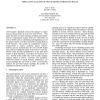Free Online Productivity Tools
i2Speak
i2Symbol
i2OCR
iTex2Img
iWeb2Print
iWeb2Shot
i2Type
iPdf2Split
iPdf2Merge
i2Bopomofo
i2Arabic
i2Style
i2Image
i2PDF
iLatex2Rtf
Sci2ools
57
Voted
WSC
2004
2004
Simulation Analysis of Truck Driver Scheduling Rules
2004 brought a landmark event in the changes to regulations governing hours of service for truck drivers. This paper describes an effort utilizing modeling and simulation for evaluating the impact of the new 2004 Hours of Service (HOS) rules in scheduling and dispatching one of the largest random over-the-road (OTR) trucking fleets in North America. The model was comprehensive and enterprise-wide in nature, modeling unique order-todelivery process characteristics for over 120,000 freight lanes and the continuous nature of the driver's work day. Model results provided quantification of the 2004 HOS impact on fleet utilization, cycle times and customer service. Results of the model were used to guide company strategy related to drivers, customers and operations. With five months of actual business performance collected regarding the new HOS in 2004, a post-mortem analysis has provided insight regarding the quality of simulation model forecasts done in 2003.
Related Content
| Added | 31 Oct 2010 |
| Updated | 31 Oct 2010 |
| Type | Conference |
| Year | 2004 |
| Where | WSC |
| Authors | Eric C. Ervin, Russell C. Harris |
Comments (0)

